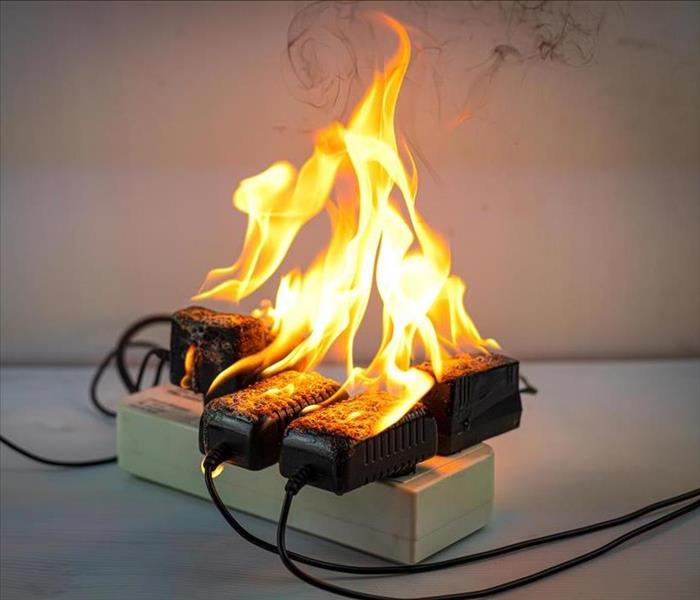Who Can Help When I Cannot Get Rid of the Smoky Odors After a House Fire?
5/19/2020 (Permalink)
 Don't have no worries if you had a fire in your Westwood home. Call SERVPRO for their specialized service.
Don't have no worries if you had a fire in your Westwood home. Call SERVPRO for their specialized service.
Westwood Residents Rely on SERVPRO to Offer Cutting-Edge Fire Damage Odor Resolution
The job of cleaning up fire damage residues is far from easy, but it eventually completes with or without the assistance of an expert disaster response company. Surfaces are clean, appliances work safely, personal possessions are cleared of corrosion and set back in place, clothing is laundered, and furniture is ready for your family to gather. As you settle back into a semblance of normalcy in your Westwood home, one fire loss related problem endures. Malodors are present despite all the cleaning and repairs. The quiet enjoyment of your home is impossible to sustain.
Is the Only Answer to Persistent Fire Damage Odor an Air Freshener?
The internet marketplaces and shelves at your local hardware or grocery store line up perfuming or masking agents as an answer to tough odors following fire damage in Westwood. Sprays, deodorant blocks, essential oils, wax melts, fabric wicks, absorbent clays, and more claim to solve your odor problem. Although we may choose briefly to employ professional masking agents as one tool, our Institute of Inspection, Cleaning and Restoration Certification (IICRC)-trained managers and technicians also have other strategies that are longer lasting or permanent solutions. Masking distracts from the foul smell, but it does not eliminate it, and its temporary nature means reapplication of the products may be necessary.
How Are Odors Linked to Fire Damage Mitigation and Remediation in General?
Odors are created during combustion. As materials burn, many chemical changes occur in reaction to the heat, oxygen level, and air pressure. Combustion unleashes toxic residues, vapors, and liquids, all of which can carry distinctly unpleasant smells. Soot particles are tiny bits of potentially hazardous and unpleasantly scented and incompletely combusted plastic, textiles, wood, food, grease, paper, and more. They float on air currents and settle on all surfaces and contents inside your home. Sometimes they get sucked into HVAC systems. Basic deodorization protocols learned and used by SERVPRO technicians during IICRC coursework recognize the link between debris and residues and odors, recommending the following multi-step protocol to work toward odor elimination:
First, remove the odor source.
If the charred debris and waste are gone, they carry the odor out of your home. Checking under and behind fixtures and furniture can reveal debris missed. When an area of a room or hall is particularly smelly, removing a portion of drywall might show burned framing, insulation, or other materials that must be removed to eliminate odors.
Second, thoroughly clean surfaces coated in the odor-bearing soots (check the entire house--these residues drift).
If the soot left behind is cleaned with appropriate products, tools, and methods, the bulk of the odors is removed as well. Be sure the interiors and tops of cabinets receive a cleaning, as well as hidden surfaces such as the top of fan blades, woodwork. Replace HVAC filters.
Third, if smells persist despite disposal and cleaning, recreate the environment present during the fire and odor penetration and apply deodorizers in the sam way.
The heat and smoke of a fire can be recreated by thermal fogging, where a heated chamber breaks down the deodorant into smaller particles that seek out, pair with, and neutralize soots, both airborne and settled.
Fourth, consider sealing surfaces that absorbed malodors.
Sealing can help in extraordinary situations like HVAC systems and attics, vaulted, or otherwise inaccessible spaces where surface cleaning is impossible. Broadcast sprayers propel sealants onto these hard to reach surfaces where they keep the malodorous vapors from leaching into the air.
Are Any Other Options Available to Eliminate Odors?
We continuously train our employees and research unique and innovative improvements in odor-elimination technology. When we find effective options that we can use safely, we add them to our arsenal of odor elimination tools.
Ozone MachinesUsed with care, usually in small, contained areas or even off-site, ozone machines can remove odors from furniture and other items. Ozone cannot be used around pets or people, limiting its application as a whole-house remedy.
Hydroxyl Generators
These machines produce molecules that seek out the odor-bearing particles. A chemical reaction occurs that alters the soot at a molecular level, neutralizing the smell. The operation of a hydroxyl generator does not put humans or pets at risk.
Enzymatic Treatments
Some products are available that break down organic-based malodors using enzymes. Often used for fabrics, they can solve odor problems with protein-based residues.
Who is better positioned to eliminate persistent fire damage odors SERVPRO of Paramus for members of our community? If smoky smells linger, give us a call at (201) 445-5588.
Contractor Licenses:
General: 13VH001305854800






 24/7 Emergency Service
24/7 Emergency Service